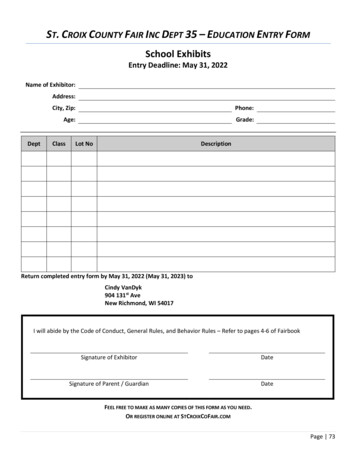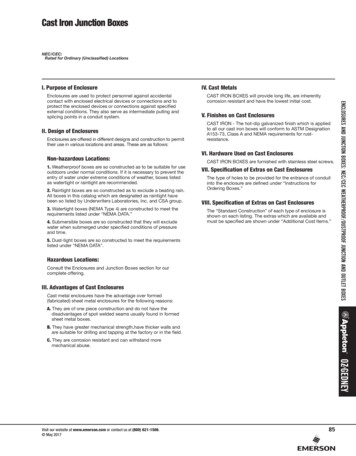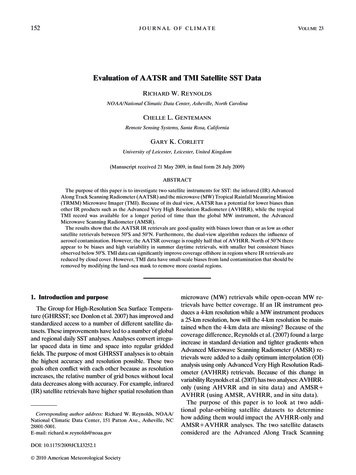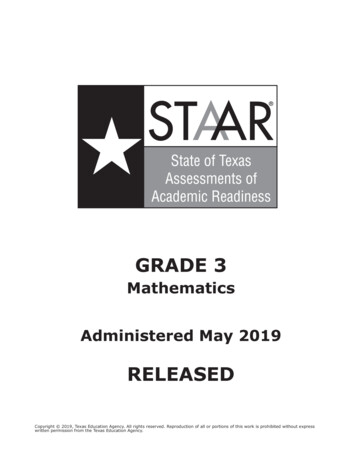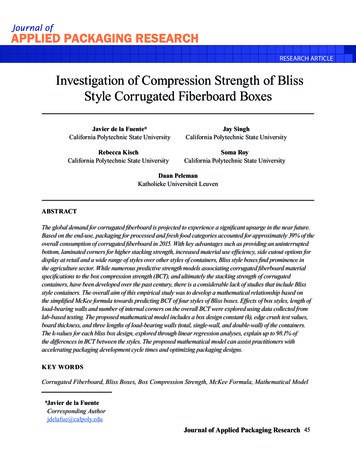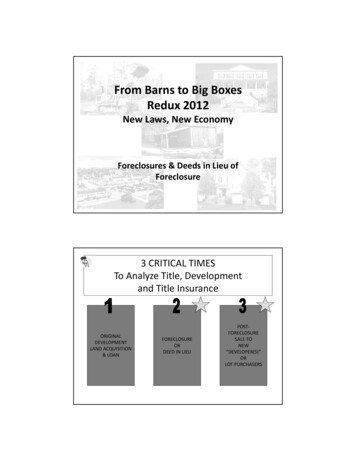
Transcription
From Barns to Big BoxesRedux 2012New Laws, New EconomyForeclosures & Deeds in Lieu ofForeclosure3 CRITICAL TIMESTo Analyze Title, Developmentand Title InsuranceORIGINALDEVELOPMENTLAND ACQUISITION& LOANFORECLOSUREORDEED IN LIEUPOST‐FORECLOSURESALE TONEW“DEVELOPER(S)”ORLOT PURCHASERS
Options Deed in lieu Power of sale foreclosure Judicial saleANSWER DEPENDS ON: Intervening liens or other interests Development documentation problems Quality of initial loan documentation Possibility of cures under any of these optionsForeclosure vs Deed In LieuForeclosureDeed in Lieu Statutory court procedure Quicker Cheaper Heavily scrutizined post‐closing (duress, adequateconsideration) Not clear prior ORintervening / subordinatematters– Typically Non‐judicial– Special Proceeding Equity of Redemption ends Subordinate mattersextinguished as liens Not clear prior matters– Priority deeds of trust– Spousal Interests– Mechanics’ liens that relateback prior to DOT recording Junior deeds of trustJudgmentsMechanics’ liensHOA dues
RECOMMEND NEW OWNER’S POLICYFOR GRANTEE OF DEED IN LIEU Owner coverage (not just loan) – first loss, not just debt capafter exhaust remedies Vesting in new owner – “Insured” Update of title through deed in lieu of foreclosure Coverage / exceptions ‐ intervening matters Satisfaction (or not) or satisfactory foreclosure of deed oftrustLENDER vs. OWNERPOST‐FORECLOSURE OR POST‐DEED‐IN‐LIEU “Continuation of Coverage”––– “Loss” calculation–– Lender must realize the loss (liquidate collateral)The Marble Bank“Insured”––– Holds note with outstanding balanceOwns the property per foreclosure or deed in lieuHas liability under warranties (rare because lenders give non‐warranties or special warranties) ortook back purchase money note from new purchaser (but doesn’t insure that purchase viability orpriority or enforceability)Lender or affiliateAssignee of noteAssignee of bid (need “Additional Insured” endorsement or new policy)Defenses against the original Insured remain“Effective Date” not post‐policy matters:–––––Compliance foreclosure proceedingNotice to owners, IRS or others requiredNo extinguishment of subordinate liens in Deed in LieuAuthority of debtor to convey deed in lieuAre post‐policy advances even covered under the particular policy?
Lender’s Loss – Foreclosure:The Marble Bank caseLender “did not suffer a loss until it foreclosed on the project. Since alender suffers loss only if the note is not repaid, the discovery of aninsured‐against lien does not trigger recognition of that loss. Only thecompletion of foreclosure signifies that a lender will not collect on itsnote. Moreover, as is typical, plaintiff selected the foreclosure date,thereby controlling to the extent possible the amount of its loss.”In this case, the lender had insured a third mortgage. The courtultimately found that since the project was not worth enough to coverthe balances on the first and second mortgage, any loss by the lenderdue to contractor’s liens with priority was not because of those liensbut because the project itself was not of sufficient value to considerthe third mortgage secured at all.Title Insurance:Coverage vs Exception Standard coverages for title matters ‐ EXAMPLES:– Access– Specific property described – the “Land”– Ownership Affirmative coverages specifically crafted based on the situationAffirmative coverage – continuing loan policy coverage (limitations) in post‐foreclosure owner’s policyExceptions– Does not imply affirmatively covered – EXAMPLES: Plats Declarations (incl. HOA dues, easements, ARC) Easements– Any matters that cannot clearly be identified as no longer applicable– Survey matters, especially post‐closing changes Exclusions from Coverage– Matters known and not disclosed to title insurer(from lender‐relationship with borrower)– Matters suffered, assumed or agreed byinsured (consents, reviews)
Creditors’ rights coverage NOT on this transaction to be insured (if notcaused by delayed or ineffective recording) DOES apply for prior transactionsRECOMMENDATION:Pre‐approval by title insurer counsel ofdeed in lieu (obligation forgiven)or foreclosure (high bid)Within last 4 yearsVS.FMV of property(current appraisals)CAUTION: Cancellation ofIndebtedness IncomeI.R.C. Sec. 61(a)(12), Sec. 108, Sec. 1017:– Cancellation “income” taxable at ordinary rates(some exclusions reduce basis in other property)– Federal exclusion for primary residenceuntil 12/31/2013 Form 1099-C (Cancellation of Debt) Publication 4681: Canceled Debts,Foreclosures, Repossessions, andAbandonments (for Individuals)www.irs.gov Æ Publications
DEEDS IN LIEU OF FORECLOSUREDifferent from a ForeclosureDifferent Risks to Assess
Deeds in Lieu of Foreclosure Deeds in Lieu (“DIL”) Conveyance by mortgagor/borrower to thebeneficiary under the deed of trust Debt forgiven Usually all secured property, but not always Why Done Borrower in defaultDebt undersecured – value of property less than debtAvoid foreclosure expenseAllow a loan workoutCan be part of bankruptcy planCONTRAST: Deeds in Lieu of Foreclosure will NOT extinguish intervening matters WILL be subject to intervening matters notcleared at DIL closing
NEW OWNER’S POLICY:Title RequirementsWarranty Deed from borrower giving deed in lieu of foreclosure (DIL) to proposed grantee reciting a fair andadequate consideration, a portion of which is satisfaction of the indebtedness (or forgiveness of personal liabilityfor debt) evidenced by the Deed of Trust. (Possibly anti‐merger exception to DOT with covenant not to sue)Satisfactory evidence or estoppel affidavit/indemnity that: DIL was given for adequate consideration (with some indication of value, whether appraisal or otherwise,and balance of outstanding debt forgiven), DIL was free of fraud, undue influence, coercion, oppression or duress, No other agreements, oral or written Grantor was not insolvent or rendered insolvent by the transaction Grantor surrendered possession of the Land, and Deed of trust has been canceled of record.Attorney’s title opinion through the DIL transaction, addressing all normal title matters, such as: INTERVENING or “SUBORDINATE” LIENS OR INTERESTS Marital rights Mechanics’ LiensNOTIFY THE TITLE COMPANY IF POSSIBLE DEED IN LIEUIN CHAIN OF TITLE WITHIN LAST 4 YEARS !!!Deed stamps on deeds It is professional misconduct for a lawyer to engage inconduct involving dishonesty, fraud, deceit, ormisrepresentation. Rule 8.4(c). Members of the public regularly rely upon theinformation about the price of real property that can bederived from tax stamps on recorded instruments. Therefore, a lawyer may not counsel or help a client toput excess tax stamps on an instrument when it isrecorded with the register of deeds because suchconduct involves dishonesty and misrepresentation. 2001 FEO 12
Overcoming DIL Challenges Borrower not in possession Lack of considerationRelease of personal liabilityCancellation of debtCancellation of deed of trustCovenant not to sue; release ofPersonal liability Transfer tax stamps on deed & recitals in deed Appraisal or evidence of value of the property Given under duress, coercion Clogging equity of redemption– Recitals that voluntary, arms length, reasonablevalue Preferential or fraudulent transfer Re‐characterization as equitable mortgageFraudulent TransfersSec. 548 (a) (1)(B)Bankruptcy trustee possesses power to void any transfer bydebtor-transferor for less than reasonably equivalent value Made while insolvent, engaged in a business havingunreasonably inadequate capital, or intended to incurdebts beyond its ability to pay. “Transfer” can encompass a mortgageor foreclosure a/w/a deed in lieu of foreclosure. Time frame: 2 years before date of PetitionAlso – NC Fraudulent Transfers Act, NCGS 39-23.9 Up to 4 years Bankruptcy Trustee may take advantage ofstate law
PreferencesUnder Bankruptcy Code – Sec. 547Transfer to a creditor1.made on account of an antecedent debt2.while debtor is insolvent,3.enabling that creditor to receive more than it would under bankruptcy(i.e. prejudice to other creditors)4.incurred by the debtor prior to filing a bankruptcy petition.Transfer made within ninety (90) days of the filing Petitionwithin one (1) year if the transferee is an insider.Must record within 30 days (deemed at time of transfer.Covered Risk 9(b) Owners’ Policy & 13(b) Loan PolicyNon-Merger:Keeping the Deed of Trust Outstanding In case need to foreclose to clear titleTypically, Grantee is SPE of noteholderGrantee Æ new owner’s policyAdequate consideration (since no deedof trust satisfaction) Provision in Deed In Lieu Loan policy endorsement
Anti-Merger: Deed ProvisionException must be stated expressly in DIL to avoidmerger of ownership & lien interests:“Title to the land described here is subject to a deed of trust dated , securedindebtedness in the amount of executed by Grantor in favor of Trustee for the benefitof Beneficiary, recorded in Book , Page , County Registry. Grantee is theholder of the entire beneficial interest under said deed of trust. Grantor and Grantee intendthat the lien of the deed of trust remain a valid lien on the land described herein after thedelivery and recordation of this Deed. The lien of the deed of trust will not merge intoGrantee’s title to the land described herein. Grantee reserves the right to extinguish the lienof the deed of trust by foreclosure or otherwise.”“Grantor has no rights to control approve or pass upon the manner in which Granteesubsequently disposes of the Land.”Anti-Merger: Add’l ProvisionNotwithstanding the fact that Grantor may be indebted to Grantee or anaffiliate of Grantee, or that Grantee or an affiliate of Grantee may haveor acquire, directly or indirectly, an interest in one or more liens orencumbrances affecting title to the property conveyed herein: This deed is intended as an absolute conveyance rather than as security forany obligation,Grantor expressly waives any statutory, equitable or other right to redeemany interest in the property conveyed herein,This deed shall not result in the merger of any such lien or encumbrancewith the title conveyed hereby, or in the subordination or extinguishment ofany such lien or encumbrance in favor of any other lien or encumbrance,andGrantor has no rights to control approve or pass upon the manner in whichGrantee subsequently disposes of the Land.
Anti-Merger:Loan Policy Endorsement“The Company hereby insures the owner of the obligation(s) securedby the Mortgage referred to in Paragraph of Schedule A againstloss which the Insured shall sustain by reason of the invalidity orunenforceability of the lien of the Mortgage upon the estate or interestreferred to in Schedule A occasioned by the title to the Land beingvested [select Option 1 or Option 2 below]:Option 1: “as shown in Paragraph of Schedule A”Option 2: “in [name grantee of deed in lieu]”NOTE: A new Owner’s Policy is required!!!Additional concerns Grantor has no rights to control approve or pass upon the manner inwhich Grantee subsequently disposes of the Land. Release of lender from lender liability & other claims Environmental concerns Subordinate (potential or actual) liens or interests Due diligence, as with any arms-length purchase (leases, insurance,personal property / taxes, CAMA) NO PRE-SALES BY LENDER/GRANTEE !! G.S. 22-2: Statute of Frauds, Contract for Sale of Land G.S. 22-5: Statute of Frauds, Commercial Loan Commitment DOCUMENT! DOCUMENT! DOCUMENT!
FOCUS TODAY:Title Issues in Distressed DevelopmentForeclosureVIEWING THIS WITH AWHOLE NEW EYE !!!Quality & Consistency ofDevelopment DocumentsQuality of loan documentation
Foreclosure Abstracts Long Form Short FormParties Lender or SPE own? Assignment of Bid vs. Assignment of Note inForeclosure Noteholder? PROVE ITDobson v Substitute Tr. Servs., Inc.,GET THE “ENTITIES” RIGHT!!
Post‐foreclosure Risks Sanitation liens On this property On all property Cities/counties looking for back tax“discoveries” Business personal property taxes HOA dues (or even complete foreclosure) Transfer of Special Declarant’s Rights Tacking – and prior owner (“buyer”)judgments & liens not checkedFHA Anti‐Flipping “Seasoning” Waiver Arms length contract ‐ no identity of interestbetween parties Seller holds title ‐ individual or "established" legitimatelyformed & operated LLC, corporation or trust No previous flips of property within past 12 months Marketed openly through MLS, auction, FSBO If the proposed price exceeds the seller’s acquisition price by20% or more: second appraisal evaluating legitimate renovations and repairs by seller or othersufficient explanation independent detailed inspection (not just of the repairs and renovations, but the entirestructure)
Fannie Mae Anti‐Flipping “Seasoning” REOInvestor Deed Restrictions“Grantee herein shall be prohibited from conveying captionedproperty to a bona fide purchaser for value for a sale prices of greaterthan ( 120% of sales price) for a period of one hundered [sic]and eighty (180) days from the date of this deed. Grantee shall also beprohibited from encumbering subject property with a security interestin the amount greater than ( 120% of sales price) for a periodof one hundred and eighty (180) days from the date of this deed.These restrictions shall run with the land and are not personal tograntee."Searching Owner Issues(again) Judgments in favor of US PMDT Preempted under US Code IRS Tax Liens – Slodov case No instantaneous seisin for constructionloans Information may affect vesting Use of entity or T by E Subordinate matters – potential problems forsale or refinance Lack of competency to hold title Broker liens
Maintenance Liens(GS 160A‐193, ‐228, ‐233, and ‐443) Mowing, trash pickup Public Nuisance Removal of building ordwelling prejudicial to publichealth & safety Property vacant for a while Often not yet filed Have super‐priorityMaintenance Liens(GS 160A‐193, ‐228, ‐233, and ‐443)Cost of repairs, alterations improvements, vacating, closing, removal ordemolition shall be:(1) a lien against the real property with same priority as a special assessmentand(2) a lien on any other real property of the owner located within the citylimits or within one mile thereof except for the owner's primaryresidence(a) The expense is a lien on the land or premises where the nuisanceoccurred with the same priority as unpaid ad valorem taxes.(b) The expense of the action is also a lien on any other real property ownedby the person in default within the city limits or within one mile of thecity limits, except for the person's primary residence, is inferior to allprior liens and shall be collected as a money judgment.
Post‐Foreclosure – you represent BloombergGraphic? another developer hoping to take over thedevelopment – remaining lots & undeveloped “futurephases” group lot builder‐buyer to build on or complete apartially completed house single lot purchaser for investment single lot/home residential purchaser lender high‐bidder at foreclosure, or their assignee – ofloan? Of high bid at foreclosure?Your client needs A minor variance waived.Plans & specs approved for proposed construction.Access through common areas of a prior phase.Amendment / clarification to the restrictions for existingviolations or needed improvements.Annexation rights for additional phases to be built onundeveloped parcelsAbility to create a valid HOA & enforce the restrictions – orto assure HOA officers, directors, budgets & procedures inplace for financial viabilityUtility accessCompliance with evolving lender regulatory requirements
On the flip side The foreclosure process may be a good time to “cleanup”development errors or problems and purge problemsfrom the title.–––––Problem declarations or amendments without lender consentsDefective platsIntervening mechanics’ liens, especially on common elementsSubordinate interestsInappropriate or inexact easements Again, it will be especially important to review ALLdocuments related to both the development and theloan, even earlier phases which may be sold out but maybe your source of access or require communication withthe owner’s association for annexation.What do Deed of Trust, Loan Agreement & otherrecorded & unrecorded closing documents address? All right title and interest to the Land &appurtenant interests (save & except releasedparcels)– CONTRAST: Just individual units General, nonspecific assignment Development rights Declarant rights All rights under the Declaration Specific itemization Consent to Declaration, Future Annexation Liabilities for common areas / improvements
Checklist: Development DocumentsDeclarationsREO Buyer NEEDS Special Declarant RightsGS 47F‐3‐104 (min) or GS 47C‐3‐104 (detailed) Get developer to assign declarantrights, even though they are no longerinvolved Problem:–They won’t cooperate–They are in bankruptcy–They are dissolved or otherwise “gone”Real Estate Title rights (insurable) vs.“benefits” (not insurable)
Development Status (or The Importance ofKnowing What’s There) Only one lot soldHalf of lots sold already75% of lots sold alreadyMultiple phases already – with differentlenders – and different foreclosuresAccess only through earlier phasesDeveloper uncooperativeMultiple purchasers of groups of lotsPhased purchase of groups of lots or tractsLegal Description of Property Foreclosed Entire development tract(s) mortgaged––––Save and except released properties (deed references)Together with appurtenant easementsTogether with important appurtenant rightsSubject to provisions restrictions, plats, easements andother benefits/burdens to be preserved (whether ornot earlier consents filed) NOT JUST residual units remaining– Which limits your ability to correct ambiguities Were undeveloped tracts shown as:– unplatted or “undeveloped” areas?– specifically reserved “for future development”?– for particular use (such as “beach,” “golf course,”“clubhouse” or “private road”)?– common elements?
Plats & More PlatsPlats & More PlatsCAG.S. 47C‐2‐109 sets forth detailed requirements for condominium plat.With regard to ongoing special declarant and development rights:(b) Each plat or plan or combination thereof must show:(10) Any unit in which the declarant has reserved the right to createadditional units or common elements.(c) A plat may also show the intended location and dimensions of anycontemplated improvement to be constructed anywhere within thecondominium. Any contemplated improvement shown must be labeledeither "MUST BE BUILT" or "NEED NOT BE BUILT".(d) Upon exercising any development right, the declarant shall record eithernew plats and plans necessary to conform to the requirements ofsubsections (a), (b), and (c) or new certifications of plats and planspreviously recorded if those plats and plans otherwise conform to therequirements of those subsections.PCAThe NC Planned Community Act has no such provisions. See G.S. 47-30,however.
Common Elements & AmenitiesG.S. 47C‐3‐104 & Proposed G.S. 47F‐3‐104 Does the lender‐purchaser have theobligation to complete? Does the lender‐purchaser have theauthority to complete? Shared facilities? Conveyed to HOA?
Access Direct? Over common elements HOA does not own? Over common elements of a prior phase, to whichbuyer cannot annex? Can buyer / does purchase comply with subdivisiondevelopment ordinances applicable? Mechanics’ liens for construction of common areas? Over common elements for which buyer cannotchange use (golf course, for example)? Vertical (elevator shafts, stairs) Horizontal (reserved rights in private roads)Access (more) Define the rights of access (pedestrian, private, public, prior phases,utilities). Identify the specific easement agreements, plats, declarations,deed appurtenances or other sources of title to the easement,rights of others and fee title holders. Is that easement assignable? Appurtenant? A license? Reservedonly for owners in earlier phases of the development? Who owns the fee – the association, other unit owners(condominium)? Were the easements as created clearly intended (per recordeddocuments) to benefit the property to be insured? What changes in development create risks of contest and litigation?
Negotiations with the HOA Are you dealing with the correct entity? Are they correctly formed? Do they have the authority (required formation,meeting and votes) to even negotiate with you?HOA DuesGS 47F‐3‐116 & GS 47C‐3‐116 (b) & (f)WARNING: Many HOA counsel assert that the lien starts when right ofredemption expires on foreclosure proceeding.PRACTICE NOTE: Foreclosure of the mortgage or deed of trust onlyextinguishes the portion of the liens which became outstanding and forwhich no claim of lien had been filed prior to the recording of the deed oftrust, through the actual sale or transfer through the foreclosure. Insituations of delayed filing of the Substitute Trustee’s deed, the closingattorney must be extremely careful to assure that the Association is bound bythe amount paid at the attorney’s closing to assure that the purchaser is notlater charged with a recalculated amount due to the delay in recording.
Stressed Associations & Developer’s Liability forHOA DuesPCACA What if the HOA can’t function otherwise?Even if not yet a lien, common element charges will“absorb” (i.e. increase for viable owners) to cover shortagesExclusion in owner’s title policy (no affirmative coverage)Obtain statement of amount owed from HOA; resolve priorto closingQuandary of when lien attaches:– Expiration of equity of redemption/final upset bid period– Recordation of trustee’s deedFront door / backdoor – if don’t collect now, will be included inpro rata shares for future years when HOA has a shortfallAt the end of the day, owners of units (whether purchasers from lender orindividual unit/lot purchaser) will absorb shortages in the HOA budget and costs!Other Easements, Liens & Encumbrances
Non‐Record MattersParties in Possession, orThe Importance of Knowing Who’s There Unrecorded leasesRecorded “Unknowns”
Warranty Deed from borrower giving deed in lieu of foreclosure (DIL) to proposed grantee reciting a fair and adequate consideration, a portion of which is satisfaction of the indebtedness (or forgiveness of personal liability . or foreclosure a/w/a deed in lieu of foreclosure. Time frame: 2 years before date of Petition
